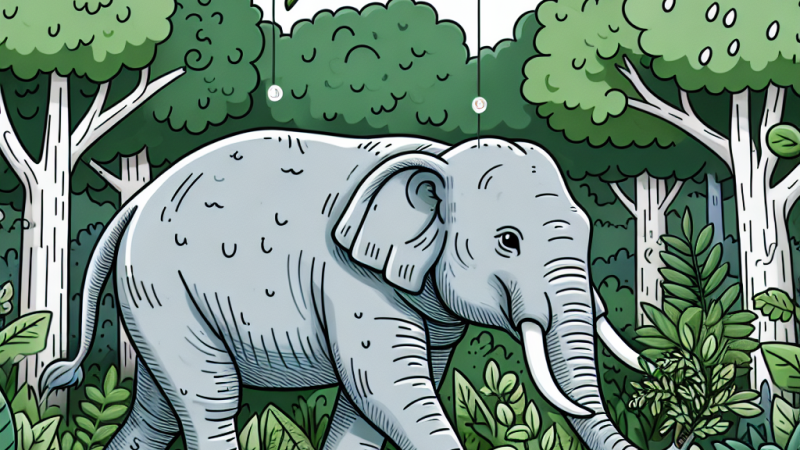Immedesimarsi in un elefante e raccontare cosa mangia in inglese
Questo lavoro è stato verificato dal nostro insegnante: 8.12.2024 o 17:00
Tipologia dell'esercizio: Tema
Aggiunto: 8.12.2024 o 16:54

Riepilogo:
La vita di un elefante ruota attorno alla ricerca di cibo: erba, foglie e frutti. Consuma 150 kg al giorno, influenzando l'ecosistema ??.
As an elephant, my life revolves around a constant quest for food. Every day, I roam the vast expanses of the savanna or the dense forests, depending on where I find myself, in search of the rich and varied diet that sustains my massive body. Food is not merely a source of energy for me; it is the centerpiece of my daily activities, dictating my movements, interactions, and even social dynamics within my herd.
One of the most delightful aspects of my diet is the sheer variety of food that I consume. I am a herbivore, and my meals consist primarily of plant material. I start my day by consuming large quantities of grass. Grass forms the staple of my diet and provides me with essential nutrients. It may seem monotonous, but there are numerous types of grass, each offering a different taste and texture. I use my trunk to pluck and pull the grass from the earth, sometimes even uprooting entire clumps to savor the roots which add an extra crunch to my meal.
While grass forms a large portion of my diet, I am also very fond of leaves and branches. As I wander through the forests or along the savanna, I come across a plethora of trees and shrubs, each offering its unique foliage. I reach up with my strong trunk, effortlessly snapping off branches to access tender leaves. Some of my favorites include acacia and baobab trees. The acacia trees, with their feathery leaves, are particularly enjoyable. Not only do they provide nourishment, but they also offer an element of interaction, as my herd members and I must often compete with giraffes for the same bounty.
Beyond grass and leaves, I also relish fruits. Seasonal changes often dictate the availability of fruits, and when they are ripe, it is a time of great joy. Fruits such as bananas, wild mangoes, and marula are savored whenever I encounter them. The marula fruit, in particular, is an exquisite treat, not only for its sweet, tangy flavor but also for the nutritional boost it provides. During the fruiting season, it becomes a focus for our herd, and we journey to areas where these fruits abound, enjoying them to our heart's content.
The quest for sustenance is not without challenges. Droughts or human activities can create scarcity, testing our endurance and requiring us to travel long distances to find adequate food supplies. Such times highlight the importance of our social bonds, as we rely on the collective wisdom of our herd to locate food. We communicate through gentle touches and low-frequency rumbles that travel over great distances, coordinating our movements and ensuring that everyone, especially the young and weak, gets enough to eat.
Interestingly, my diet is not limited to readily available food. My environment often provides unexpected surprises. Occasionally, I have the opportunity to dig for minerals and salts in the soil, which are essential for maintaining my health. These natural supplements are sought after, and I use my tusks to churn the earth and extract these precious minerals, which help balance my diet.
As an elephant, the amount of food I need is staggering. On average, I consume around 150 kilograms of food every day. This requires constant foraging and eating for up to 18 hours a day. The vast quantity of food I consume is not only a necessity for my survival but also plays a vital role in my ecosystem. My feeding habits aid in seed dispersal, and my movement through the landscape creates pathways that benefit other smaller animals.
Moreover, our foraging activities facilitate the growth of vegetation. By browsing on trees and shrubs, we stimulate new growth, maintaining the balance of our habitat. This interconnectedness with the environment is crucial, and it highlights the symbiosis between us elephants and the natural world around us.
In conclusion, as an elephant, what I eat is a journey through the flavors of the natural world, driven by necessity and opportunity. My diet is a manifestation of my role within the ecosystem, my social interactions, and my adaptation to the challenges of nature. It is a testament to the resilience and complexity of life in the wild.
Ocena nauczyciela:
Questo lavoro è stato verificato dal nostro insegnante: 8.12.2024 o 17:00
Sull'insegnante: Insegnante - Marta S.
Ho 13 anni di esperienza nella secondaria. Insegno a pianificare, scegliere esempi e formulare tesi solide in linea con i criteri dell’Esame di Stato; con le classi più giovani preparo alla prova di terza media. Creo un ritmo di lavoro tranquillo con tempo per domande e revisione, aumentando la sicurezza in sede d’esame.
**Voto:** 10- **Commento:** Ottima capacità di immedesimazione e descrizione dettagliata della dieta dell'elefante.
Komentarze naszych użytkowników:
Vota:
Accedi per poter valutare il lavoro.
Accedi